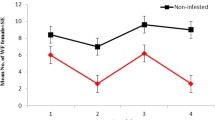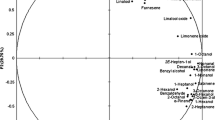Summary.
Summary. Oilseed rape, Brassica napus L. (cv Express), plants were grown under three different sulphur regimes: sulphur-free (S0), normal sulphur (Sn, normal field concentration) and a sulphur-rich (S+, 2 × concentration of Sn). We performed dual choice oviposition assays with the diamondback moth, Plutella xylostella, using real plants and, for the first time with this insect, artificial leaves sprayed with methanolic leaf-surface extracts. The results mirrored those of a separate study of preferences for whole plants. Females laid more eggs on surrogate leaves that were treated with Sn extracts than on S0 plants, while only a slight, not significant, difference was observed between extracts of normal and sulphur-rich plants. This shows that chemical compounds on the leaf surface mediate the oviposition preference and that the female insect can perceive the quality of the host-plants in terms of their fertilisation status.
Since leaf volatiles are known to be oviposition stimulants, we investigated the effects of leaf-surface extracts on insect olfactory responses using electroantennograms (EAGs). In agreement with the behavioural data, we found that extracts of sulphur-treated plants yielded higher EAG amplitudes than the S0 extracts. Since the leaf content of the volatiles isothiocyanates is influenced by sulphur nutrition, we analysed the extracts for these compounds. Above the detection threshold of our GC-MS system, no isothiocyanates were found. Thus, other compounds present in the surface extracts must be perceived by the antenna.
However, the HPLC analysis revealed 11 different glucosinolates. Progoitrin (2-Hydroxy-3-butenyl) and gluconapoleiferin (2-Hydroxy-4-pentenyl), which belong to the hydroxy-alkene class of glucosinolates, were the most abundant compounds. The total glucosinolate content sharply increased from S0 to Sn plants, whereas it was slightly lower in n versus S+ plants. Since it is known that glucosinolates can stimulate oviposition, it seems likely that the increased content we observed was influencing the insect preference in this study too.
Similar content being viewed by others
Author information
Authors and Affiliations
Corresponding author
Rights and permissions
About this article
Cite this article
Marazzi, C., Patrian, B. & Städler, E. Secondary metabolites of the leaf surface affected by sulphur fertilisation and perceived by the diamondback moth. Chemoecology 14, 81–86 (2004). https://doi.org/10.1007/s00049-003-0264-y
Received:
Accepted:
Issue Date:
DOI: https://doi.org/10.1007/s00049-003-0264-y




